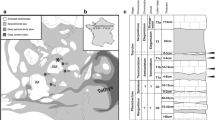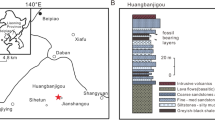Summary
A previously unknown, very large barn owl,Basityto rummeli is described from the early Miocene of Grafenmühle 21 in Bavaria, Germany. This raises the number of tytonine genera known from the early Miocene to three.Necrobyas is known only from France,Prosybris from France and Austria, andBasityto so far only from Germany.
Further taxonomic conclusions are as follows:Palaeotyto cadurcensis Mourer-Chauviré,Palaeobyas cracrafti Mourer-Chauviré, andTyto edwardsi (Gaillard) are excluded from the Tytoninae. Six species are synonymized:Necrobyas rossignoli Milne-Edwards withNecrobyas harpax Milne-Edwards,Necrobyas edwardsi Gaillard withNecrobyas arvernensis (Milne-Edwards),Necrobyas minimus Mourer-Chauviré withProsybris antiqua (Milne-Edwards),Tyto campiterrae Jánossy withTyto sanctialbani (Lydekker),Tyto robusta Ballmann withTyto gigantea Ballmann, andTyto melitensis (Lydekker) withTyto alba (Scopoli).Necrobyas medius Mourer-Chauviré was transferred to the genusProsybris. In addition,Strix ignota “Milne-Edwards” andStrix ignota “Paris” emerge as not available for nomenclatural purposes.
Zusammenfassung
Eine neue, sehr große Schleiereule,Basityto rummeli, wird aus dem Untermiozän von Grafenmühle 21 in Bayern beschrieben. Damit ist die Anzahl der aus dem Untermiozän bekannten Schleiereulengattungen auf drei gestiegen.Necrobyas ist bisher nur aus Frankreich,Prosybris aus Frankreich und Österreich, undBasityto aus Bayern bekannt. Weitere taxonomische Ergebnisse sind wie folgt:Palaeotyto cadurcensis Mourer-Chauviré,Palaeobyas cracrafti Mourer-Chauviré undTyto edwardsi (Gaillard) wurden aus den Tytoninae entfernt. Sechs Arten wurden synonymisiert:Necrobyas rossignoli Milne-Edwards mitNecrobyas harpax Milne-Edwards,Necrobyas edwardsi Gaillard mitNecrobyas arvernensis (Milne-Edwards),Necrobyas minimus Mourer-Chauviré mitProsybris antiqua (Milne-Edwards),Tyto campiterrae Jánossy mitTyto sanctialbani (Lydekker),Tyto robusta Ballmann mitTyto gigantea Ballmann undTyto melitensis (Lydekker) mitTyto alba (Scopoli).Necrobyas medius Mourer-Chauviré wurde in die GattungProsybris überführt. Die NamenStrix ignota „Milne-Edwards“ undStrix ignota „Paris“ sind für nomenklatorische Zwecke nicht verfügbar.
Similar content being viewed by others
References
Arredondo, O. (1972a): Nueva especie de ave fósil (Strigiformes: Tytonidae) del Pleistoceno superior de Cuba. Bol. Soc. venezol. Cienc. nat. 29: 415–431.
Arredondo, O. (1972b): Especie nueva de lechuza (Strigiformes: Tytonidae) del Pleistoceno cubano. Bol. Soc. venezol. Cienc. nat. 30: 129–140.
Arredondo, O. (1976): The great predatory birds of the Pleistocene of Cuba. In: Olson, S.L. (ed.): Collected papers in avian paleontology honoring the 90th birthday of Alexander Wetmore. Smithson. Contrib. Paleobiol. 27: 169–187.
Bachmayer, F. (1980): Ein fossiler Vogelrest aus den Diatomeen-Schiefern (Miozän, Ottnangien) von Limberg, Niederösterreich. Ann. naturhist. Mus. Wien 83: 25–28.
Ballmann, P. (1969a): Die Vögel aus der altburdigalen Spaltenfüllung von Wintershof (West) bei Eichstätt in Bayern. Zitteliana 1: 5–61.
Ballmann, P. (1969b): Les oiseaux miocènes de La Grive-Saint-Alban (Isère). Géobios 2: 157–204.
Ballmann, P. (1973): Fossile Vögel aus dem Neogen der Halbinsel Gargano (Italien). Scripta geol. 17: 1–75.
Ballmann, P. (1976): Fossile Vögel aus dem Neogen der Halbinsel Gargano (Italien), zweiter Teil. Scripta geol. 38: 1–59.
Balouet, J.C. & Olson, S.L. (1989): Fossil birds from late Quaternary deposits in New Caledonia. Smithson. Contrib. Zool. 469: 1–38.
Becker, J.J. (1987): Neogene avian localities of North America. Washington, D.C.
Brodkorb, P. (1970): Two fossil owls from the Aquitanian of France. Quart. J. Florida Acad. Sci. 32: 159–160.
Brodkorb, P. (1971): Catalogue of fossil birds: Part 4 (Columbiformes through Piciformes). Bull. Florida State Mus. (Biol. Sci.) 15: 163–266.
Brodkorb, P. & Mourer-Chauviré, C. (1984): Fossil owls from early Man sites of Olduvai Gorge, Tanzania. Ostrich 54: 17–27.
Burton, J.A. (ed., 1973): Owls of the world. New York.
Chandler, R.M. (1982): A reevaluation of the Pliocene owlLechusa stirtoni Miller. Auk 99: 580–581.
Cheneval, J. & Adrover, R. (“1993” = 1995): L'avifaune du Miocène supérieur d'Aljezar B (Los Aljezares, Province de Teruel, Espagne). Systématique et paléoécologie. Paleontologia i Evolució 26–27: 133–144.
Delle Cave, L. (1996): Tertiary avian localities of Italy. In: Mlíkovský, J. (ed.): Tertiary avian localities of Europe. Acta Univ. Carol. (Geologica) 39: 665–681.
Eck, S. & Busse, H. (1973): Eulen (Aves, Strigidae). Wittenberg Lutherstadt.
Ennouchi, E. (1930): Contribution à l'étude de la faune du Tortonien de la Grive-Saint-Alban (Isère). Paris.
Freudenthal, M. (1971): Neogene vertebrates from the Gargano Peninsula, Italy. Scripta geol. 14: 1–19.
Freudenthal, M. (1972):Deinogalerix koenigswaldi nov. gen., nov. spec., a giant insectivore from the Neogene of Italy. Scripta geol. 14: 1–19.
Freudenthal, M. (1976): Rodent stratigraphy of some Miocene fissure fillings in Gargano. Scripta geol. 37: 1–23.
Gaillard, C. (1908): Les oiseaux des Phosphorites du Quercy. Ann. Univ. Lyon (n.s.) 23: 1–178.
Gaillard, C. (1939): Contribution à l'étude des oiseaux fossiles. Nouv. Arch. Mus. Lyon 15 (2): 1–100.
Haffer, J. (1995): Species versus lineages. In: Peters, D.S. (ed.): Acta palaeornithologica. Courier Forschungsinst. Senokenberg 181: 303–309.
Heissig, K. (1978): Fossilführende Spaltenfüllungen Süddeutschlands und die Ökologie ihrer oligozänen Huftiere. Mitt. bayer. Staatssamml. Paläontol. hist. Geol. 18: 237–288.
Horáček, I. & Ložek, V. (1988): Palaeozoology and the mid-European Quaternary past: scope of the approach and selected results. Praha.
Jánossy, D. (1991): Late Miocene bird remains from Polgárdi (W-Hungary). Aquila 98: 13–35.
Lambrecht, K. (1921): Pars 12 Aves. In: Diener, C. (ed.): Fossilium catalogus. I. Animalia. Berlin.
Lambrecht, K. (1933): Handbuch der Palaeornithologie. Berlin.
Lydekker, R. (1891): Catalogue of the fossil birds in the British Museum (Natural History). London.
Lydekker, R. (1893): On some bird remains from the Miocene of La Grive-Saint-Alban, Department of Isere, France. Proc. zool. Soc. London 1893: 517–522.
Mein, P. (1990): Updating of MN zones. In: Lindsay, E.H., Fahlbusch, V. & Mein, P. (eds.): European Neogene mammal chronology: 73–90. New York.
Miller, L. (1956): A collection of bird remains from the Pliocene of San Diego, California. Proc. California Acad. Sci. 28: 615–621.
Milne-Edwards, A. (1863): Mémoire sur la distribution géologique des oiseaux fossiles et description de quelques espéces nouvelles. Ann. Sci. nat. (4) 20: 132–176.
Milne-Edwards, A. (1869): Recherches anatomiques et paléontologiques pour servir à l'histoire des oiseaux fossiles de la France. Vol. 2. Paris: Victor Masson et Fils. (+ Atlas 1869–1871).
Milne-Edwards, A. (1892): Sur les oiseaux fossiles des dépots èocenes de phosphate de chaux du Sud de la France. C.R. 2e Congr. ornithol. internat. 2: 60–80.
Mlíkovský, J. (1992): The present state of knowledge of the Tertiary birds of Central Europe. In: Campbell, K.E. (ed.): Papers in avian paleontology honoring Pierce Brodkorb. Nat. Hist. Mus. Los Angeles Co., Sci. Ser. 36: 433–458.
Mlíkovský, J. (1996a): Tertiary avian localities of Austria. In: Mlíkovsky, J. (ed.): Tertiary avian localities of Europe. Acta Univ. Carol. (Geologica) 39: 529–533.
Mlíkovský, J. (1996b): Tertiary avian faunas of Europe. In: Mlíkovský, J. (ed.): Tertiary avian localities of Europe. Acta Univ. Carol. (Geologica) 39: 777–818.
Mlíkovský, J. (in press): Early Miocene birds of Jebel Zelten, Libya. Acta Univ. Carol. (Geologica).
Mlíkovský, J., Bělka, L. & Zemek, K. (1985): Morphogenesis and the problem of morphospecies. In: Mlíkovský, J. & Novák, V.J.A. (eds.): Evolution and morphogenesis: 201–211. Praha.
Mlíkovský, J. & Hesse, A. (1996): Tertiary avian localities of Germany. In: Mlíkovský, J. (ed.): Tertiary avian localities of Europe. Acta Univ. Carol. (Geologica) 39: 619–647.
Mourer-Chauviré, C. (1987): Les Strigiformes (Aves) des Phosphorites du Quercy (France): systématique, biostratigraphie et paléobiogeographie. In: Mourer-Chauviré, C. (ed.): L'évolution des oiseaux d'après le témoignage des fossiles. Docum. Lab. Géol. Lyon 99: 89–135.
Mourer-Chauviré, C. (1994): A large owl from the Palaeocene of France. Palaeontology 37: 339–348.
Mourer-Chauviré, C. (1995): Dynamics of the avifauna during the Paleogene and the early Neogene of France. Settling of the recent fauna. Acta zool. cracov. 38: 325–342.
Mourer-Chauviré, C. (1996): Paleogene avian localities of France. In: Mlíkovský, J. (ed.): Tertiary avian localities of Europe. Acta Univ. Carol. 39: 567–598.
Mourer-Chauviré, C. & Sanchez Marco, A. (1988): Présence deTyto balearica (Aves, Strigiformes) dans des gisements continentaux du Pliocene de France et d'Espagne. Géobios 21: 639–644.
Mourer-Chauviré, C., J.A. Alcover, S. Moya & J. Pons (1980): Une nouvelle forme insulaire d'effraie géante,Tyto balearica n. sp., (Aves, Strigiformes), du Plio-Pleistocène des Baleares. Géobios 13: 803–811.
Mourer-Chauviré, C., Bour, R., Moutou, F. & Ribes, S. (1994):Mascarenotus nov. gen. (Aves, Strigiformes), genre endémique éteint des Mascareignes etM. grucheti n. sp., espèce éteinte de La Réunion. C. R. Acad. Sci. Paris (II) 318: 1699–1706.
Newton, E. & Gadow, H. (1893): On additional bones of the dodo and other extinct birds of Mauritius obtained by Mr. Théodore Sauzier. Trans. Zool. Soc. London 13: 281–302.
Olson, S.L. & Hilgartner, W.B. (1982): Fossil and subfossil birds from the Bahamas. In: Olson, S.L. (ed.): Fossil vertebrates from the Bahamas. Smithson. Contrib. Paleobiol. 48: 22–60.
Paris, P. (1912): Oiseaux fossiles de France. Rev. franç. Ornithol. 37: 283–298.
Peters, D.S. (1992): A new species of owl (Aves: Strigiformes) from the middle Eocene Messel oil shale. In: Campbell, K.E. (ed.): Papers in avian paleontology honoring Pierce Brodkorb. Nat. Hist. Mus. Los Angeles Co., Sci. Ser. 36: 161–169.
Pomerol, C. & Premoli-Silva, I. (eds., 1986): Terminal Eocene events. Amsterdam.
Rémy, J.A., Crochet, J.Y., Sigé, B., Sudre, J., de Bonis, L., Vianey-Liaud, M., Godinot, M., Hartenberger, J.L., Lange-Badré, B. & Comte, B. (1987): Biochronologie des Phosphorites du Quercy: Mise à jour des listes faunistiques et nouveaux gisements de mammifères fossiles. In: Schmidt-Kittler, N. (ed.): International symposium on mammalian stratigraphy and paleoecology of the European Paleogene. Münchner geowiss. Abh. (A) 10: 169–188.
Rich, P.V. & Bohaska, D. (1976): The world's oldest owl: a new strigiform from the Paleocene of southwestern Colorado. In: Olson, S.L. (ed.): Collected papers in avian paleontology honoring the 90th birthsday of Alexander Wetmore. Smithson. Contrib. Paleobiol. 27: 87–93.
Rich, P.V. & Bohaska, D. (1981): The Ogygoptyngidae, a new family of owls from the Paleocene of North America. Alcheringa 5: 95–102.
Rothschild, W. (1907): Extinct birds. London.
Salotti, M., Bailon, S., Bonifay, M.-F., Courtois, J.-Y., Dubois, J.-N., Ferrandini, J., Ferrandini, M., La Milza, L.-C., Mourer-Chauviré, C., Popelard, J.-B., Quinif, Y., Réal-Testud, A.-M., Miniconi, C., Pereira, E. & Persiani, C. (1997): Castiglione 3, un nouveau remplissage fossilifère d'âge Pléistocène moyen dans le karst de la région d'Oletta (Haute-Corse). C.R. Acad. Sci. Paris (IIa) 324: 67–74.
Schmidt-Kittler, N. (1987): European reference levels and correlation tables. In: Schmidt-Kittler, N. (ed.): International symposium on mammalian stratigraphy and paleoecology of the European Paleogene. Münchner geowiss. Abh. (A) 10: 13–19.
Schneider, W. (1977): Schleiereulen (Tytonidae). Wittenberg Lutherstadt.
Wetmore, A. (1920): Five new species of birds from cave deposits in Porto Rico. Proc. biol. Soc. Washington 33: 77–82.
Wetmore, A. (1922): Remains of birds from caves in the Republic of Haiti. Smithson. misc. Coll. 74 (4): 1–4.
Wetmore, A. (1937): Bird remains from cave deposits on Great Exuma Island in the Bahamas. Bull. Mus. comp. Zool. 80: 427–441.
Wolters, H.E. (1975–1982): Die Vogelarten der Erde. Hamburg.
Author information
Authors and Affiliations
Rights and permissions
About this article
Cite this article
Mlíkovský, J. A new barn owl (Aves: Strigidae) from the early Miocene of Germany, with comments on the fossil history of the Tytoninae. J Ornithol 139, 247–261 (1998). https://doi.org/10.1007/BF01653335
Accepted:
Published:
Issue Date:
DOI: https://doi.org/10.1007/BF01653335




